Do you want to give your walls an unusual and non-standard texture? You have three options.
The easiest is to apply real materials, for example, for a metal effect, cover the wall with metal plates, and to give a velvet effect, paste over it with velvet, and so on. But it's going to be crazy inconvenient and expensive!
Method two - apply textured plaster, using lines and other shapes to give the shape of bricks, rocks, or a number of other materials. This material is significantly superior to the first in terms of convenience, but it can only imitate a certain list of materials.
And finally the third, and the most convenient way, which we are talking about in this article - decorative wall paint. The second part of the article will talk about textured paint, which is not so easy at first to distinguish from decorative.
Differences between decorative paint and ordinary paint
The differences from ordinary paint in materials are the most insignificant, the point here is different - in the very method of application. When applying decorative and textured coatings technique is very important.
But, nevertheless, only a limited list of structures can be made with ordinary paint, so specialized decorative paint is still necessary. With her help you can create a huge variety of different patterns– from silk to metal and from wood to rocks. This is facilitated by special additives present in the composition of the paint, as well as other substances that are absent in ordinary paint.
Most often, paint is used to imitate silk. Such a wall allows you to literally shimmer in the light rays, especially if you slowly walk through such a room.
By the way, such paint is much thicker than ordinary paint, so you can also make a relief with it, since She keeps her shape much better.. To paint the walls in your apartment, you can use Isosilcolor, Seta, Cebostyle, or another brand of paint.
Types of decorative paint surfaces
First of all, the first and main color is applied using an ordinary wide brush or roller. This shade is necessary to set off the next one under the rays of the sun. A day later, when this first color has already dried, decorative paint, using a trowel (a special tool similar to a spatula), at an angle of about ten to fifteen degrees, is applied to the surface with circular strokes. After about twelve hours, after allowing the first layer to dry a little, the second layer should be applied., trying to ensure that the strokes intersect at as large an angle as possible. 
sandy effect
Compared to a silk effect, a less thick paint of the same type is required to achieve a sandy effect. On a previously leveled surface draw vertical lines. Their length should be about thirty centimeters, and from each other they should be at a distance of five to eight centimeters. After performing these thick strokes, a layer of paint is immediately applied on top, which should be rubbed into the wall, but the lines should remain clearly visible. At first, the resulting effect seems terrifying, but as soon as the paint dries, you are already enjoying the “falling” sand, sitting on a cozy sofa with a cup of tea. By the way, such the effect is quite budgetary, since the paint for it will cost a little.  metallic effect
metallic effect
Another fairly popular way. In this case paint is applied to putty or plaster, or on another surface, previously treated with finishing putty. By using wet roller with a short pile should apply two basic coats making the surface as smooth as possible. When the first coat is dry, cross-stroke decorative paint. Avoid visual overlaps and after complete drying you will be able to enjoy a very beautiful surface that looks like it is made of metal. 
A person who does not have experience in such matters is unlikely to distinguish textured paint from decorative. She too has a relief, but not so deep, and if necessary rinses off much easier. Such paints are made mainly from acrylic and are water-based.

- The main difficulty in applying textured paint– to achieve the depth of the relief, as well as a long effect. To ensure these factors, the paint must be thick enough, not become less durable due to moisture and harden reliably and forever, that is, a simple water-based paint will not cope with this task, and therefore in textured paint various additives are used.
- We prepare the work surface before painting - we level it, as well as a good primer. It is worth considering that some experts use a mesh to create a relief when puttying, this provides better paint retention, but this method should only be used when using budget paints, high-quality paints do not require this.
- When preparing textured paint, dilute it with a solvent only in very small proportions. Since ordinary water-based paint is not suitable in this case, we recommend using paint from foreign manufacturers such as Tex, Decorative, Eurowies or their analogues. Thicker paint will lay down evenly. Paint should be calculated as follows: for one square meter usually diverges around one kilogram of paint. Thus, the cost of such repairs will be quite high.
- We wait until the primer dries, after which we proceed to the very painting of the already prepared walls. Different effects will be obtained when using various tools. You can use:
- stencil;
- curly or ordinary roller;
- coarse brush;
- trowel.

If you use trowel, first thing paint is applied and then with this tool attached required form (e.g. stone).
rough brush you can create wave effect, drawing rather thin lines on the freshly applied paint.
Stamp or stencil allow create a pre-prepared texture on freshly painted surfaces. Work should be done smoothly and slowly to avoid unnecessary streaks that spoil the view.
Advice: a figured roller creates a repetition of the structure over the entire surface, while with a regular roller, about ten minutes after applying fresh paint, you can create an interesting ripple effect.

None of our options fit? No problem! We put on gloves and go ahead, create your own author's and unique structure! :)
It is only worth remembering that you can decorate in about fifteen minutes, then the paint is already starting to harden, and it will no longer be possible to make a beautiful texture, and therefore work better together. After finishing work, you can toned some individual areas to emphasize the relief and give an additional effect.
Photo of textured wall paint









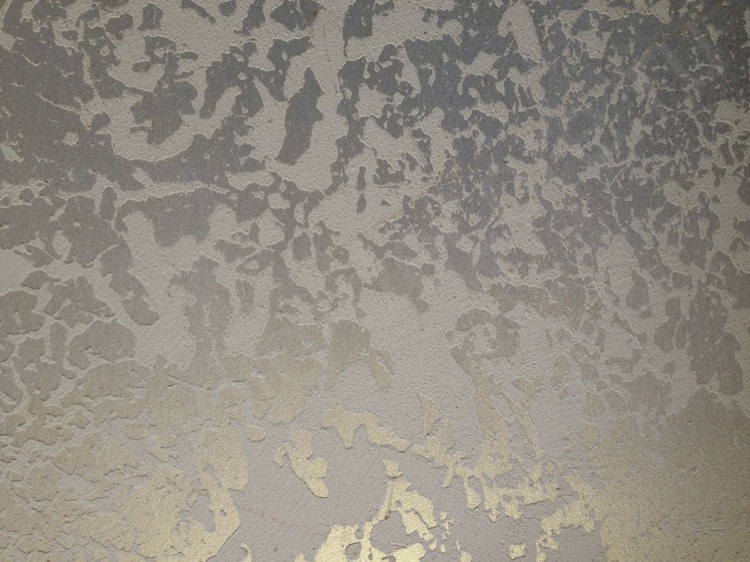
We are already accustomed to the fact that paint can be moisture resistant, hypoallergenic and suitable for wet cleaning, and it can also reflect light and optically enlarge a room. Manufacturers do not stop there and offer new ideas. What was new a few years ago is becoming the standard today. So, let's see what's in fashion now, and what interesting products the manufacturers offer.

Modern wall paints not only provide walls with an interesting color, they can have different properties and effects. You may like decorative wall paint with a silk or velvet effect, or maybe slate and magnetic, there are also finishes that absorb odors. There are many options, how not to get confused in a building supermarket and what to look for when choosing paints and varnishes, we will tell in this article.
There are various colorful products used for creative room decoration. With their help, you can interesting and original way enliven any space, regardless of whether it is an apartment, office or public space. An interesting line of colors with which we get an amazing silk effect.

This is a high quality decorative paint designed for indoor use. In its composition, it has special mother-of-pearl fillers, with the help of which a coating with a noble sheen is formed on the surface. Flickering dynamic reflections change depending on the angle of the light. It can be tinted with various dyes and pigments, and after drying it creates a strong and washable film.

The substrate for its application must be dry, smooth, free from dust, paint and adhesives. All loose materials must be removed and the surface leveled. New plaster can be painted only after 3-4 weeks. The surface must be primed first. There are three ways to apply this paint:
- using a Venetian spatula;
- with a brush;
- roller.
It should be remembered that the maximum thickness of the applied layer should be 1 mm. The decorative effect is formed immediately after application and alignment of the applied mass in different directions. The finished coating dries within 12 hours. Such decorative trim non-flammable and completely safe for people. After completion of work, it is enough to simply ventilate the room.
Velvet Effect Wall Paint
Decorative paints with a velvet effect create a delicate, fine-grained texture on the wall that imitates various materials. Thus, we can create not only a colored, but also a structural surface. An amazing result is given by a paint that imitates a velvet effect. Its composition makes it possible to obtain color effects and tactile sensations on the surface, similar to those that characterize antique furniture upholstery in Damascus. Walls painted with this paint will look like soft fabric, it looks very elegant.

Thus, we can give our interior a warm and cozy character. Velvet effect paint contains special metallic pigments. Their presence on the surface gently reflects the light, making the room visually more spacious than it really is.

The product can be used both for painting walls and ceilings in rooms. This covering is especially recommended for a bedroom, a drawing room, offices.
They allow you to create colored multifunctional "boards" in the rooms. You can make a blackboard in the kitchen that will serve as a sticky note for your favorite recipes, a home "message board" or a "gallery" of photos and drawings in the kitchen or children's room. In the children's room, such coatings make it possible to create a surface on which young creators will be happy to create their works without fear of the wrath of their parents.
Today, marker and slate paints do not have to be exclusively black. The modern "chalkboard" on the wall of your apartment can be in a variety of colors:
- black;
- grey;
- green;
- blue;
- and even pink.
This certainly gives us more options, making it easier for us to implement different solutions for different interiors.
Because even in small rooms, you can use a large section of the wall to create such a surface without fear of overloading the room excessively.
Massive gray looks great in a nursery, but fans of pink also have a rich palette of shades in which everyone will find something for themselves.
 A wall painted in this way offers interesting possibilities for interior design. It can be themed decorations or themed decorations for different seasons, holidays, birthdays, etc.
A wall painted in this way offers interesting possibilities for interior design. It can be themed decorations or themed decorations for different seasons, holidays, birthdays, etc.
It will find its application in private housing, as well as in kindergartens and schools, children's rooms and development centers. Not to mention that it provides a chance for the artistic expression of the youngest members of the family. At the same time, your wallpaper in the living room will be saved from the encroachments of young artists.
Such a slate surface is well suited for the implementation of small decorative solutions. This paint can be applied to a piece of furniture, wooden frames, or even a cut piece of plywood. Applied to a jar or other kitchen container, it creates a creative label with an easy-to-change slogan. As a result, throughout the apartment, you can place elements that are in harmony with the magnetic marker wall created on some of the surfaces.

Two-component paints are also available on the market, with which you can easily turn a wall into a marker board and an interactive whiteboard. It gives a smooth and stable finish, resulting in a surface that you can write on with crayons or markers. The paint is easy to apply on almost any surface:
- drywall wall;
- wood;
- stone;
- cement;
- metal.
The main condition is a smooth base. So if you want to combine it with magnetic paint, then the surface must first be smoothed.
Special magnetic paint is made on the basis of acrylic resin with the addition of microscopic iron particles. To achieve the best effect on the wall, apply it in several layers. Optimal - 3-4 layers. The safe and non-toxic product can be successfully applied in the children's room or in the kitchen. The only drawback is the rather difficult application due to the thick consistency. After complete drying, such a surface can be painted with any paint for internal works. If we cover it with marker paint, we will get a truly multifunctional wall.

Tile paint
Renovating a bathroom or toilet is a challenge if you don't want to do a big renovation. Now you don't have to knock down a beautifully placed tile just because you got bored with its color or the previous owner of the apartment had a completely different taste. This is where tile paint comes in handy. Very durable and resistant, especially to moisture, it is suitable for use on floors and walls. Although there are no miracles: intensive use of the room, especially on the floor, can lead to scratches after a few years. It is applied mainly with a roller or brush, but be careful: tile paint is quite thick and dries quickly. We must also take into account the seams that can be repainted with a brush.
Odor neutralizing paint
This finish is suitable for the rooms of heavy smokers and new home owners where there is an intense smell. building materials. Using odor-absorbing paint helps to remove them. How does it work? The substances contained in its composition reduce the spread of odor in the room. It itself does not emit any odors and is used indoors to improve their microclimate.
The product is positioned as environmentally friendly and absolutely safe even for small children or allergy sufferers. It is also quite often used to decorate the walls of the kitchen and toilet.
Decorative painting is one of the most common modern ways wall finishing. It is quite practical and at the same time looks very aesthetically pleasing, the only thing is that the choice of paintwork requires a competent and responsible approach. Therefore, below we will consider which paints can be used for these purposes and get acquainted with some of their features.
General information
First of all, let's consider what a decorative wall painting is in general. Sometimes this is called ordinary painting. However, most often this term means painting with patterns, drawings, textures, etc., applied to the walls.
Therefore, the paint during decorative staining is applied in several layers that differ in color. Moreover, for its application, not only standard tools are used - a paint roller and brushes, but also various other devices. The most common among them are structural rollers, which have three-dimensional patterns or texture.
In general, there are a lot of options for how to apply decorative wall paint. Sponges, dry brushes with hard bristles, plastic bags and much more are also used for this.
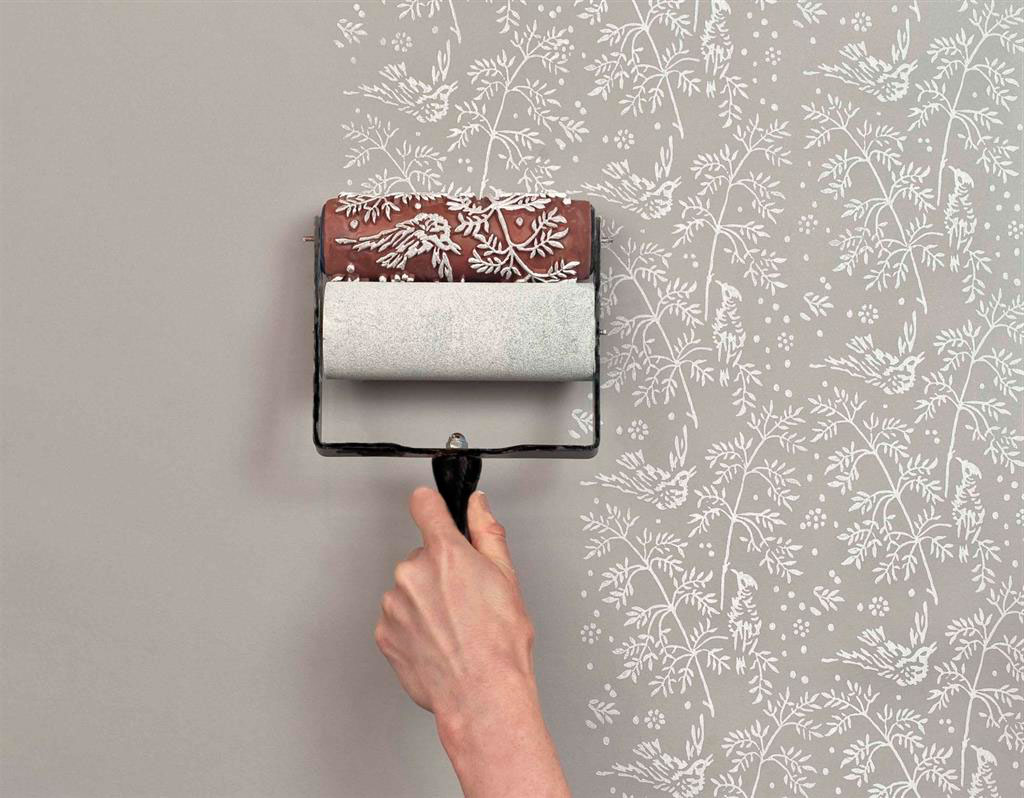
Decorative painting also includes the application of textured paint. This coating is a special material that is applied to the surface with a spatula and is more like decorative plaster.
Below we will get acquainted with all the options for paintwork that can be used for decorative.
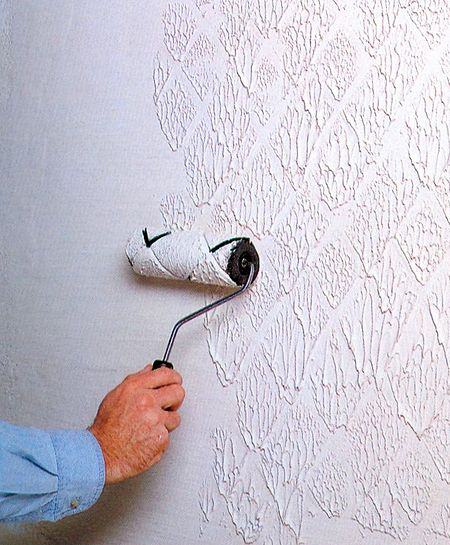
smooth painting
For smooth decorative painting of walls, the same compositions are used as for plain coloring. Fortunately, the times when oil paints were used for these purposes are far in the past.
Nowadays, there are water-dispersion paint coatings on the market that are designed specifically for painting walls and ceilings. Their main advantage lies in their environmental friendliness and lack of smell, in addition, they dry out very quickly.
The rest of the performance characteristics of different compositions may vary. Therefore, below we will get acquainted with some types of paints from the most famous manufacturers on the domestic market.
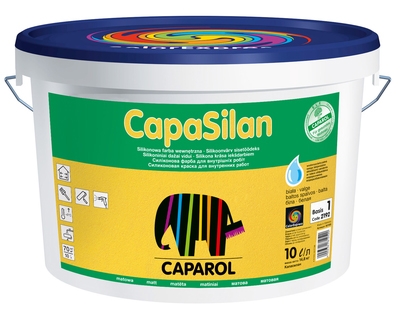
Caparol CapaSilan
Caparol is a well-known German manufacturer whose paint and varnish coatings are distinguished by their durability and high performance. A prominent representative of these paints is the silicone coating CapaSilan.
In addition to environmental friendliness, this paint has the following positive qualities:
- increased wear resistance;
- does not contain active matting and chalking substances;
- has a high degree of vapor permeability;
- easy to apply, and you can paint adjacent sections of the wall in different time, and at the same time there are no visible docking points;
- like all silicone paints, it has good elasticity;
- does not attract dust;
- thanks to moisture resistance, it is possible to carry out wet cleaning of walls and also to use a covering in rooms with high humidity.
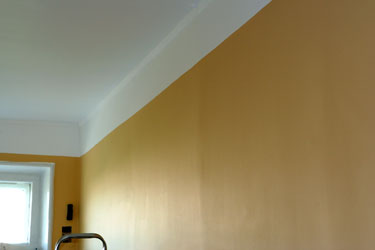
The disadvantages of the material include only the high price of ~ 6400 rubles per 12 liters. Below are the main characteristics of this coating:
Thus, this paint is an excellent choice for rooms with increased operational load on the walls, for example, in the kitchen or in the children's room, where wet cleaning will be regularly performed. Due to its characteristics, this coating will last for a long time.
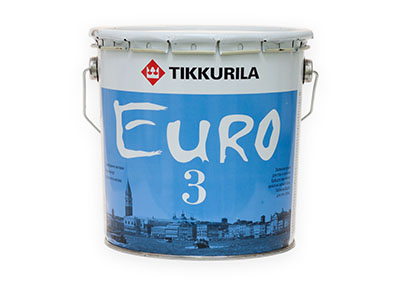
Tikkurila Euro 3
Euro 3 is one of the most popular interior paints. This coating is intended for use in dry rooms.
Advice! For wet rooms, you can use paint from Tikkurila - Luja. Its characteristics are in many ways similar to Euro 3, with the exception of moisture resistance.
Like all coatings from the Finnish manufacturer Tikkurila, this paint has high performance:
- due to its high environmental friendliness, it is recommended for use in children's rooms, as well as kindergartens and medical institutions;
- has good adhesion to different surfaces- concrete walls, drywall, fiberboard and chipboard, as well as other materials;
- able to hide minor surface flaws, in particular, small cracks up to 2 mm wide;
- withstands up to 5000 wet cleaning cycles with a soft sponge;
- has a sufficiently high heat resistance - can withstand temperatures up to +85 degrees.
The cost of this coverage is also quite high - 2500 rubles. for a bucket with a capacity of 9 liters. Below we consider its main characteristics:
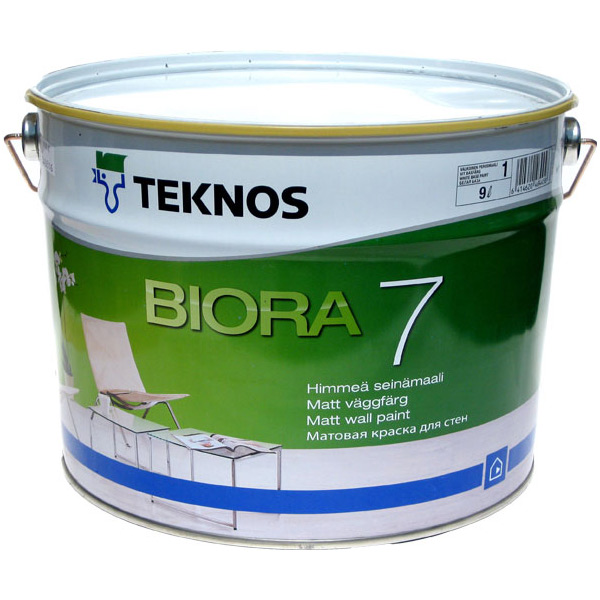
Teknos Biora 7
Biora 7 is an acrylic paint from another well-known Finnish manufacturer of paints and varnishes - Teknos. Like all of the above paints, this composition is absolutely environmentally friendly.
Biora 7 forms a matte film on the surface, resistant to abrasion and wet cleaning. Moreover, according to these indicators, the paint surpasses even CapaSilan and Euro Matt 3, as it belongs to the first class of resistance to wet abrasion. But, nevertheless, the area of its purpose is limited to dry rooms.
Another feature of this coating is good hiding power. For these reasons, the cost of Biora 7 is higher than for many other types. acrylic paint~ 4,800 rubles for a bucket with a capacity of 9 liters.
Note! Instructions for the use of water-dispersion coatings allow painting at a temperature not lower than +5 degrees Celsius.
The main characteristics of this paint are as follows:
Note! The complete formation of the protective layer occurs only after 4 weeks from the moment of painting.
In general, Biora 7 is a good alternative to Euro 3, especially if the walls are prone to contamination. However, it should be borne in mind that acrylic paint requires more careful preparation of the base than latex. Therefore, if there are small defects on the surface of the walls, it is better to use Euro 3.
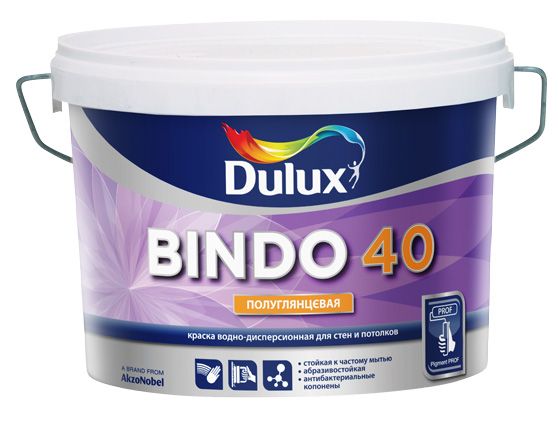
Dulux Bindo 40
Bindo 40 is a high quality acrylic paint from the English manufacturer Dulux. This composition also has many positive qualities:
- suitable for use in wet rooms, as it tolerates the formation of condensate;
- resistant to wet cleaning with detergents;
- easy to clean, in particular, it will not be difficult to wash off stains from coffee, juice, etc. from this coating;
- easy to apply - lays down in an even layer, while not splashing;
- has good resistance to abrasion, so it can be used in rooms with increased load - in halls, stairwells, etc.
The cost of Bindo 40 is 4,800 rubles. for 10 liters. As for the characteristics, they are in many ways similar to the above compositions:
As a result, this paint is the best choice for bathrooms, kitchens, as well as rooms with increased load on the walls.
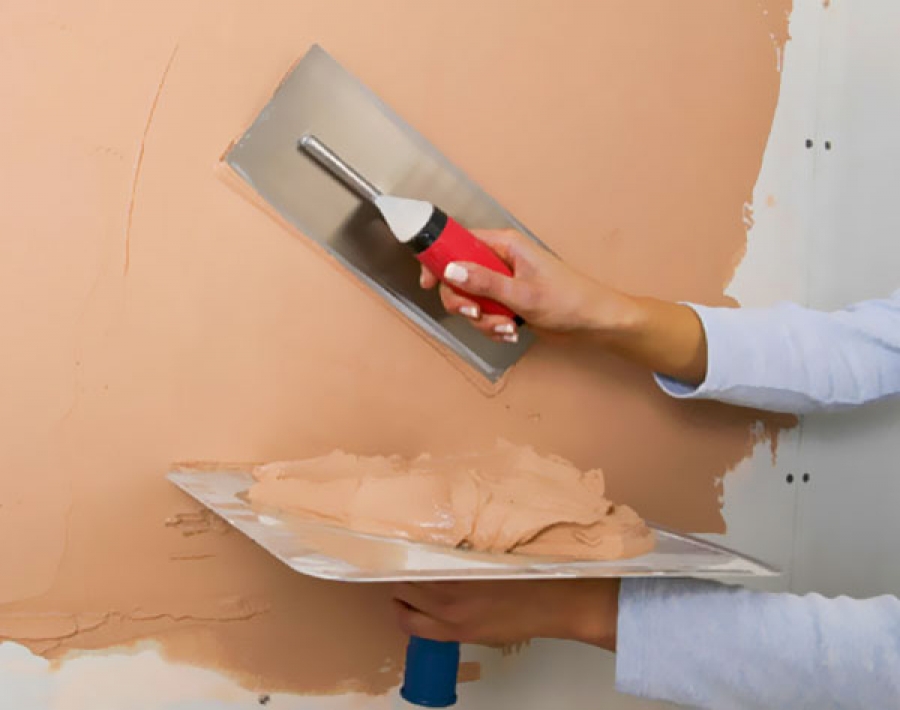
Textured paints
As mentioned above, textured paint is a fairly thick coating that is applied with a spatula or small paint. It should be noted that this material can be both tinted and painted with conventional interior paints.
In the case of using interior paints, do-it-yourself decorative wall painting is carried out in several stages:
- applying textured paint to the wall;
- formation of invoices with special tools;
- surface painting - for these purposes, you can use one of the above paints.
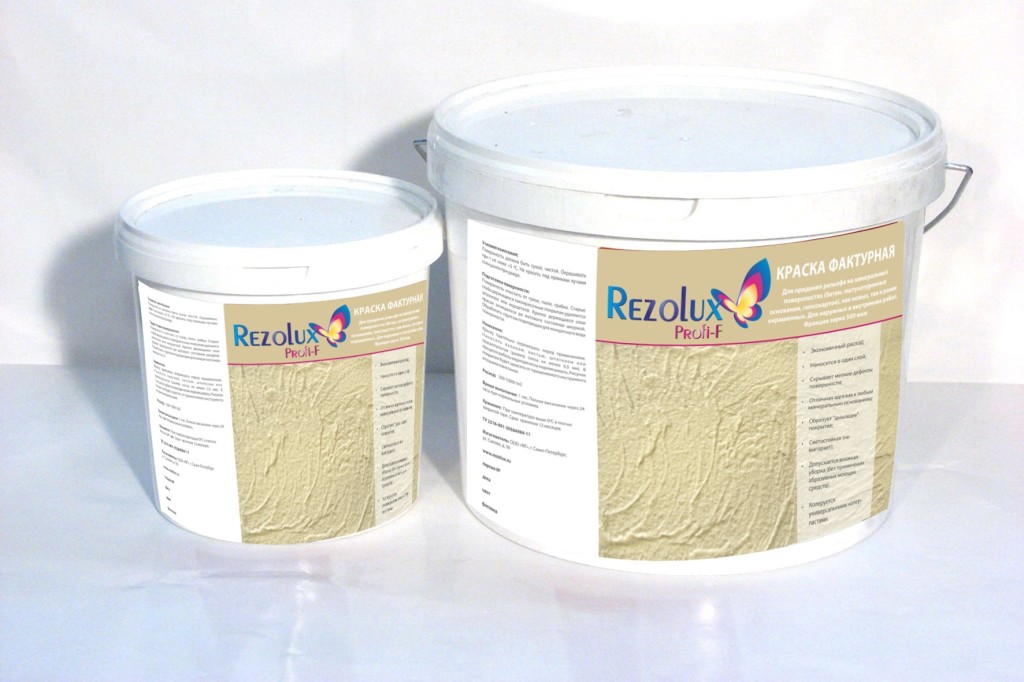
Rezolux Profi-F
Profi - F is a textured paint from a domestic manufacturer, which can be used for both indoor and outdoor work.
The performance of this composition is at a high level:
- can be applied to concrete, drywall, plastered and puttied surfaces;
- withstands wet cleaning with the use of detergents (without abrasive substances);
- has high strength;
- is a vapor-permeable coating;
- can be tinted by hand.
The advantages of this coating also include a low cost - 1,200 rubles per 18 kg. Consumption is 0.5 - 1 kg per square meter.
In general, this is an inexpensive, but at the same time high-quality universal textured paint, which allows you not only to decorate the walls, but also to hide their minor defects.

In the photo - textured coating Parade W200
Parade W200
The Israeli company Parade is a well-known manufacturer of paint and varnish coatings that have proven themselves throughout the world.
Among the most important qualities of the W200 are the following points:
- high strength, due to which the paint can be used in rooms where there is an increased operational load on the walls - flights of stairs and cages, etc .;
- resistance to atmospheric influences, including temperature extremes;
- has good vapor permeability;
- the possibility of transportation and short-term storage at temperatures up to -35 degrees Celsius (no more than five freeze / thaw cycles are allowed).
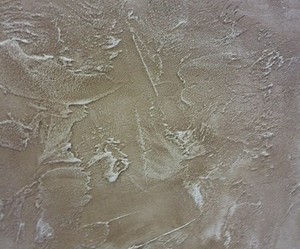
Below are the main characteristics of the W200:
The cost of this paint is quite high - about 3000 rubles for a bucket with a capacity of 10 liters. However, given its characteristics, in general, the price / quality ratio is not bad.
Advice! In the process of wall decoration, it often becomes necessary to paint pipes of various communications. For heating systems (fireplaces and chimneys), fire-retardant paints for metal Polistil can be used. For other metal structures, an excellent solution is Zinga conductive paint, which reliably protects the metal from corrosion.
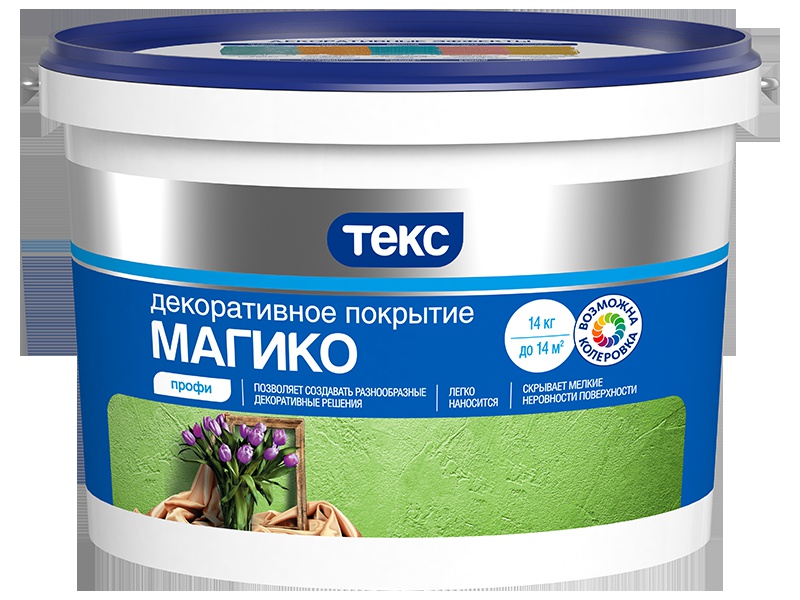
Tex Magico
Textured paint Magico is another domestic decorative wall covering. The Tex company, which is the manufacturer of this composition, has been a leader in the domestic market for more than 15 years, which indicates high quality her products.
Magico paint is made in the best traditions of this company, as evidenced by its high performance, which is not inferior to foreign analogues. In particular, this composition can also be used for indoor and outdoor use.
On the walls, the coating forms a visually attractive and pleasant to the touch velvety surface. Due to the elasticity, various decorative effects are easily realized. The only drawback of this composition is the possibility of tinting only in pastel colors.
The cost of Magico paint is about 1100 rubles for a bucket with a capacity of 14 liters. As for consumption, it is about the same as for other similar coatings - about 1.4 kg per square meter.
With this paint we will complete our short review. Of course, there are many other coatings on the market that are also worthy of attention. However, all the above paints have been tested by time and a huge number of buyers, so there is no doubt about their quality.
Conclusion
Provide decorative painting walls can be used with ordinary interior paints, as well as textured coatings. When choosing these paints and varnishes, it is better to give preference to products from famous brands whose products are guaranteed to be of the highest quality.
The video in this article contains additional useful information. If some of your questions remain unanswered, ask them in the comments, and we will be happy to answer them.
During the renovation, everyone tries to make their home as attractive as possible. An excellent option for those who also want to save money at the same time is decorative wall paint. It looks no worse than expensive analogues, and a wide range modern materials allows you to implement any design ideas. We list the main types of decorative paints, and also consider the method of their application.
Types of decorative paint
Decorative wall paint is divided into two groups:
- used for outdoor work;
- applied indoors.

In addition, paints are classified according to the type of film-forming substance into:
- oil;
- enamel;
- adhesive;
- water-based.
The first two types of decorative paints are called alkyd. They can be used for both exterior and interior wall decoration. They are not afraid of exposure to water and sunlight, but at the same time they are fire hazardous and have a low level of resistance to alkalis. They are mainly used for painting wooden, metal and plastered surfaces. They can be applied with a roller, brush or spray gun. Decorative paint is diluted with drying oil and turpentine. Before finishing the walls with alkyd paint, you need to ventilate the room well for better adhesion.

Adhesive decorative materials for wall decoration are based on polyvinyl alcohol, starch, cellulose, casein and other components. The main advantage of adhesive paints is the presence of small pores, due to which moisture evaporates faster, and the walls themselves breathe better. According to the method of application and properties, this material is similar to emulsion paints.
A feature of water-based and emulsion decorative paints is that the binder base is dispersed with pigments in a single medium, which makes it possible to create a moisture-resistant suspension. If water gets on a wall painted with such material, it will simply evaporate without penetrating inside. With help water-based paints you can maintain an optimal indoor climate, they are fireproof, non-toxic and do not exfoliate.

You can apply them to the wall with a roller, brush or spray gun, which will help to achieve the best result. They are suitable for finishing almost any surface, except for varnished and adhesive. Such paint is well washed off the hands and applied to the surface without any problems.
Classification of water-based paints
There are several types of water-based paints:
- acrylic;
- polyvinyl acetate;
- latex;
- silicate;
- silicone;
- mineral.
Let's consider each of them in more detail. Acrylic paints are the most popular. They are made on acrylic resins, due to which they have high strength and elasticity. They are not afraid of wet cleaning and do not wash off for a long time, but it is better not to apply them in places where water is likely to get in. For hand tinted decorative acrylic paint uses a computer tinting system that allows you to choose the most suitable shade.
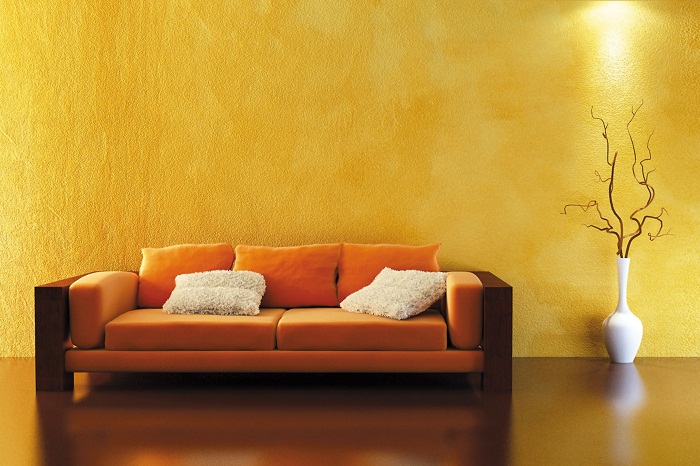
Latex paints are considered the most expensive paints for wall decoration in an apartment. They are resistant to abrasion, and the surface painted with them will have the effect of silk.
Silicate paint is a liquid glass-based solution mixed with a colored pigment. Due to the formation of strong chemical bonds with the coating, the paint fuses well with it and is not afraid of atmospheric influences. Such decorative paints make the walls air and vapor permeable. The service life of the material is 20 years. Are used both for internal, and for external works. When applied to a tree, they make it protected from fire.
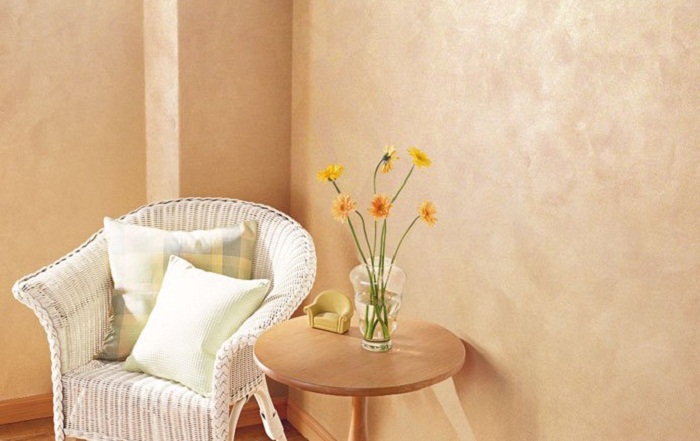
No less popular for interior decoration are silicone paints. They are made on the basis of silicone resin, which is why they are characterized by high elasticity, hygiene and vapor permeability.
Applying paint to the walls
The use of each of the above types of decorative paints requires certain preparatory work. The wall must be cleaned of the old coating as efficiently as possible and treated with special means. Depending on the degree of adhesion, a primer is used or abrasive treatment is carried out. Tools are also selected depending on the type of wall paint chosen.

The main purpose of using decorative paints is to create a variety of effects. Consider the most common of them (you can see examples in the photo).
- Matte silk effect
It can be achieved by adding polymer sawdust to the material. Also in the composition there is water, pigment and acrylic resin as a binding component. When creating the effect of silk, the paint dries quickly enough and is not afraid of atmospheric influences.

- Multicolor or mosaic wall
To realize this effect, you need to use several colors, but without mixing them together. One of them acts to color the base, and with the help of the second a certain pattern is created.
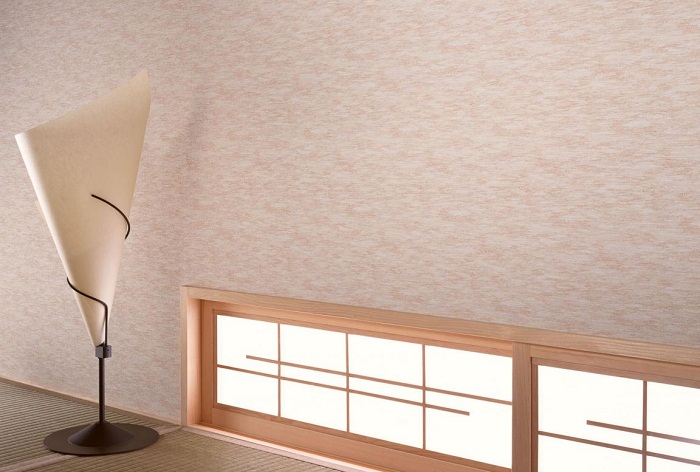
- The effect of antiquity
With simple decorative wall paints, it is quite possible to create a unique classic design. They allow you to create a worn effect, imitate cracking antique walls or a surface with remnants of gilding.
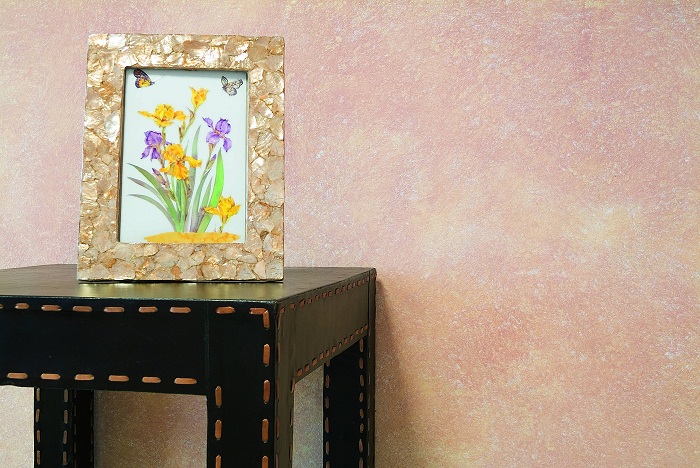
- Metal surface of the walls
A great option for creating a high-tech interior. Painting with shades of copper, silver, metallic or gold allows you to make futuristic decor elements out of ordinary walls.
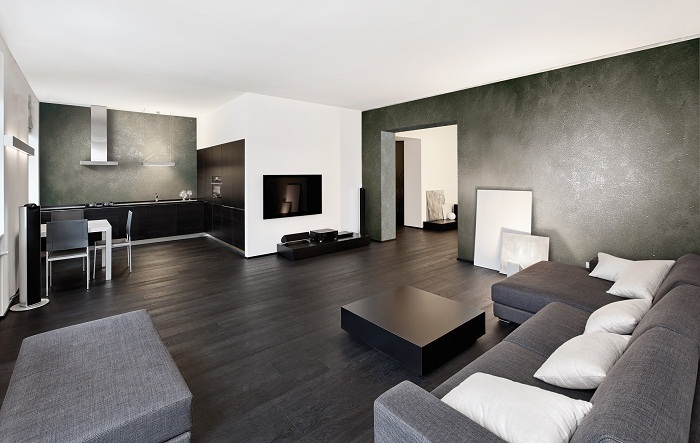
- natural surface
Most often, this choice when decorating walls is made by amateurs. natural materials. This effect is created due to the texture of the material. All kinds of shells, pebbles, sand and other mineral additives can be added to it. With their help, you can get the effect of the sea, sand dune, snow storm and much more (you can see examples in the photo). The main task remains to choose the right shade, from which the realism of the expected texture will depend.
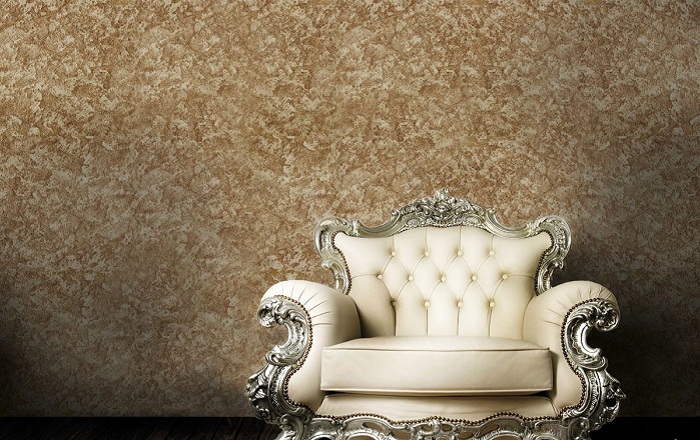
This list of possible decorative effects that you can create in your apartment is far from exhaustive. Every day there are more and more options, new textures and technologies appear. Given this, you can easily choose the right option for your interior. A video will also help you with this, where you will learn even more information on a topic that interests you.
One of the most important points in the interior design of the room is the decoration of the walls. Of course, you can just stick wallpaper, but if you want to give the room individuality and originality, then it is better to make a decorative painting. Decorative paint is becoming an increasingly popular material for surface finishing in the domestic construction market.
Advantages and disadvantages of decorative paint
The main advantage of using decorative paints is to give the room an original decorative effect. But besides this, there are a number of other positive aspects:
- The widest selection of colors, textures and patterns.
- Practicality. Decorative paint is not afraid of mold, dirt rarely appears on it, and even if they appear, they are easily washed off.
- Safety. Decorative paints do not contain impurities harmful to health and are absolutely non-flammable.
- Anti-static, which prevents the formation of dust on the coating.
- Resistance to mechanical damage.
- Masking cracks, bumps and other minor defects.
- High vapor permeability, which contributes to the natural regulation of humidity, and prevents the formation of condensate between the wall and the covering.
- Breadth of application. Decorative paint can be applied to different types of surfaces: brick, concrete, wood.
- UV resistant to color fading.
- The absence of joints, which gives a more harmonious look to the room.
- Long service life (about 10 years).
Of course, like any other material, decorative paint has its drawbacks, but they are limited to only two points:
- The surface on which the paint will be applied must be carefully prepared.
- High price.
Applying decorative paint
Preparatory stage
Before painting the walls, it is necessary to carefully prepare them. Remove traces of wallpaper, old paint, whitewash, glue, as they all have a different chemical composition, which can affect the final result in an unpredictable way.
If it is not possible to completely remove the previously glued wallpaper, then you can use an alkyd primer. The primer is diluted with white spirit in a ratio of one to three, mixed well and applied to problem areas. Use acetone or gasoline to remove oil stains. If there are cracks, they must be primed. To do this, it is better to use the densest substance possible, preferably finely dispersed, for example, cement or gypsum, as well as their solutions. Wet the cracks with water before priming to maximize the adhesion of the surface to the primer.

Also, before starting work, it is worth pasting over the sockets and switches on the wall with tape.
Buying paint
The choice of material is a process that requires attention and patience. Don't leave it to the last minute.
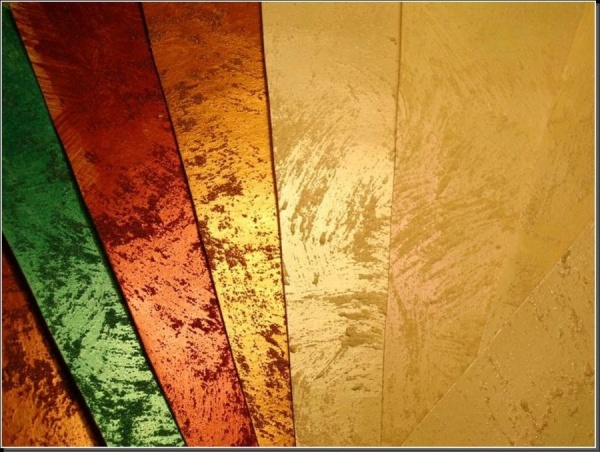
Before starting staining, it is worth trying out the purchased coating on an inconspicuous area. This must be done in order to understand how quickly it dries, whether it changes color and whether cracks appear after drying, whether it has an odor, and also to identify the approximate consumption of material.
Important ! When purchasing decorative paint, check the expiration date so as not to buy an expired product.
Decorative painting can be done in two ways:
- With texture paint. This method is more expensive, but more original.
- With ordinary paint, thanks to the combination of colors and the use of stencils and patterns.
You can learn how to paint the walls correctly by watching the video below:
Painting with regular paint
Wall paints have a fairly liquid consistency, so when applied, stains, lumps, etc. are not formed.
Attention ! Start applying paint only after the surface is completely prepared and dry. Otherwise, defects may occur.
Painting in most cases is carried out in several layers. When using a spray gun, you can limit yourself to one layer. But most often the coloring of the room is done manually with a brush and roller.
The paint must be applied evenly and start from those areas where furniture will be located, carpets will hang, and also where there is the least light. This is necessary in order to fill your hand and possible defects were invisible. Apply each new layer after the previous one has completely dried.
Attention ! Apply the last layer in the direction of the sun rays falling on the surface to be painted.
decoration
Stencil
A stencil can be used to apply a pattern to the wall to be painted. It is purchased in a store or made independently from thin linoleum, sheet plastic or dense film. The main thing is that the material from which the stencil is made does not collapse when a brush or roller moves over it, as a result of which the pattern may become blurry and have uneven edges.
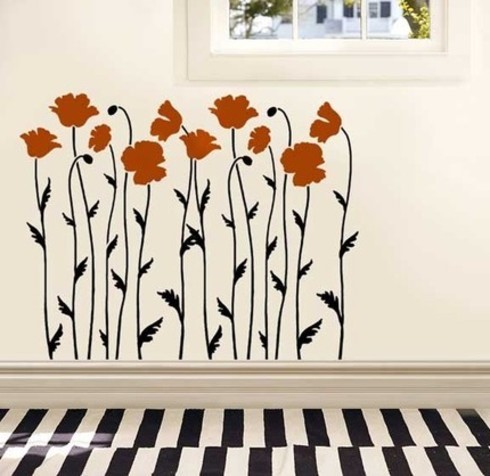
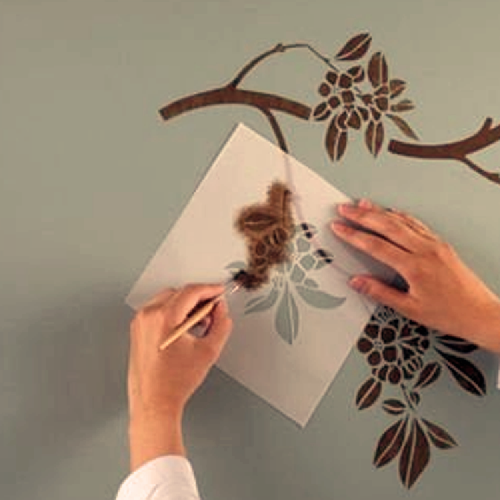
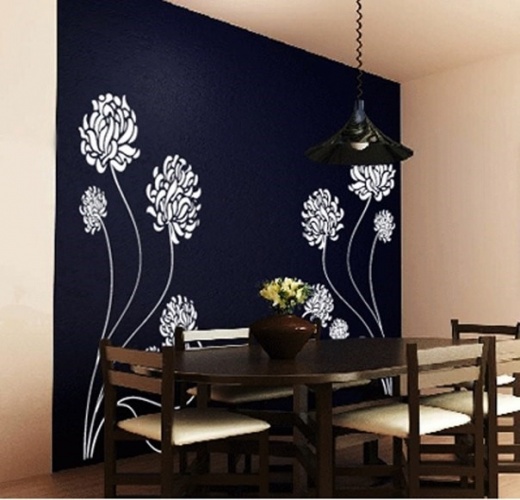
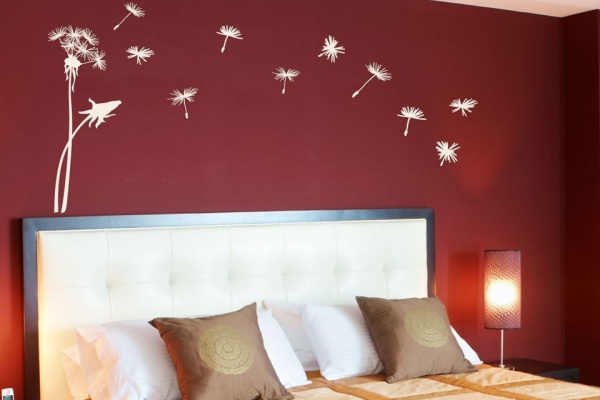
Stardust effect
A simple but interesting effect can be created by applying flecks of a different shade to the main color of the wall. To do this, use a brush with hard bristles. It is dipped in paint, squeezed out, then the pile is folded in the opposite direction from the wall and released. Before applying this effect, practice on some unnecessary surface.
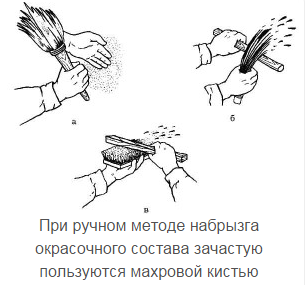
contrast effect
A room with plainly painted walls looks spectacular, but in different colors. Or different parts of the same wall can be painted in different colors. It can be squares, rhombuses or other shapes. Before starting work, draw a design on paper.


aging effect
Paint of a contrasting color is applied to a uniformly painted surface and, without waiting for it to dry, the surface is repeatedly touched with a brush with hard bristles. This effect can be spread over all painted walls or it can be used zoned. You can use a hard dry sponge to create this effect. The main thing is that the application is uniform and in the same style.
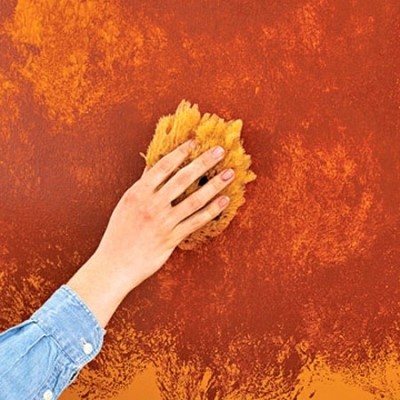
Chaotic pattern
To create this effect, use a roller with torn fabrics tied to it.
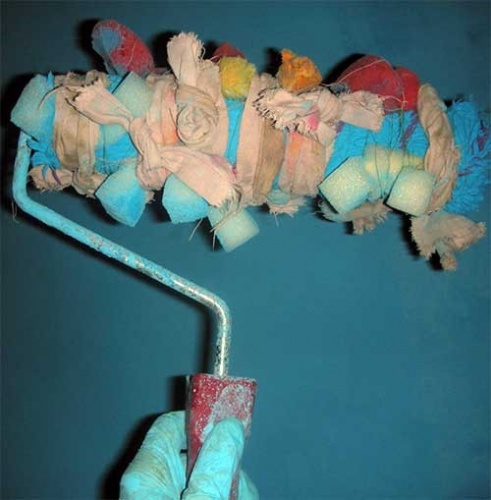
The applied chaotic pattern should have a color different from the main staining.
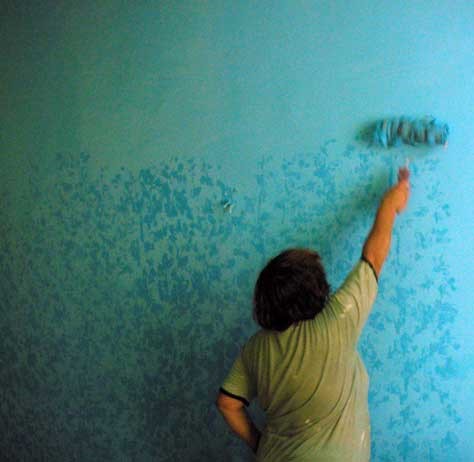
Applying textured paint
Textured decorative paint in its characteristics resembles decorative plaster. But the paint is more plastic and looks more elegant.
To create a relief, before the paint dries, a pattern is applied to it, for which you can use a special roller, brushes, brushes, combs, tracing paper, and even your own hands.

To give an additional effect on the main color, you can apply regular paint in a contrasting color or even several colors with a soft brush. But to create such effects, you need to have experience, so practice on an unnecessary surface before painting.


Advice ! To make the coating last longer and have a more expressive look, interior varnish can be applied to it.
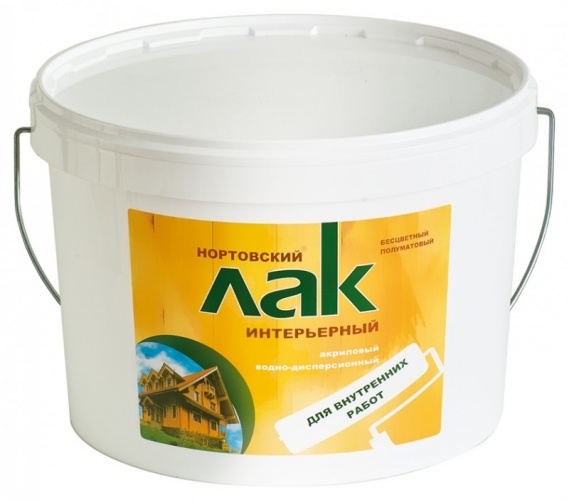
- It is necessary to carry out staining in the warm season or in a heated room. Otherwise, you are threatened with at least a long drying time, as a maximum change appearance and reduced service life.
- If you want to create a transparent effect, then you should purchase a decorative paint with a glazing composition, if transparency is not needed, then the composition should be opaque.
- To visually expand the room, use paints with a glossy effect, but remember that even minor defects can become visible on gloss, but a matte finish will help hide these defects.
- The more relief the layer of applied paint, the larger defects it can hide.
- When buying paint, check the information on the degree of its wear resistance. For respectable manufacturers, the jar usually indicates the number of cleanings that it can withstand.
- If you are going to paint the walls in a room with high humidity, then choose materials that contain antifungal additives and antiseptics.
- If you want extravagance and brightness, remember that everything should be in moderation. Place drawings and bright effects on one, maximum two walls of the room.
- Know that saturated color visually narrows the space, while properly selected and thoughtful decorative inserts can create the opposite effect.
- Decorative painting should begin only after the plan for arranging furniture has been thought out.




















